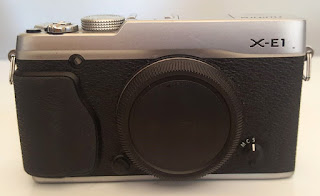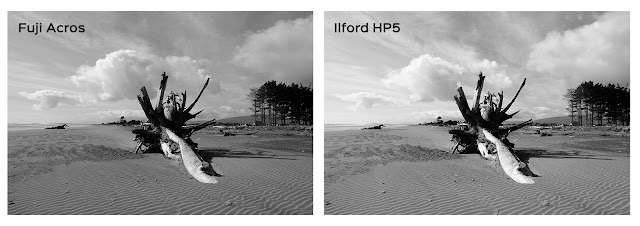Old blog - new tricks!
Well hello, hello. As incredible as it may seem - and I can hardly believe it myself - after almost six and a half years of absolutely no activity, this blog finally has a new post!
I began the Fuji X (10) Files (as it was called then) way back in February 2013, to chronicle my move from DLSR's to the Fujifilm X10 compact camera. It was not, however, a roaring success, and I sold the camera after only a few months and ten blog posts.
It was a lovely little compact camera, but the very early EXR Fuji sensor was plagued with conversion problems i.e - third party software struggled to convert the RAF (Fuji RAW) files. That eventually got sorted, but I also personally struggled to 'downsize' to the very compact X10 after a lifetime spent using SLR-style cameras with interchangeable lenses. I liked the 'idea' of a compact camera, but quickly discovered the reality didn't match the ideal.
Over the ensuing six years I've moved around camera systems a lot. Sometimes through necessity, but often through choice. The relentless tide of mirrorless has well and truly hit the mainstream, and I've tried to find a home for it in my own arsenal, with mixed success. Olympus has often been my mirrorless system of choice, and I was quite settled with the OM-D E-M1 for a while. But I've also struggled to let go of my DSLR roots. So much so, that only very recently I sold all my OM-D E-M1 gear to move back to a Canon DLSR setup (to then very quickly change that out for Nikon).
It's taken me six years, but I've finally realised that there really is no 'one' camera to rule them all (yes, I'm a bit slow on the uptake). Instead, I've decided to allow myself the luxury of owning two different systems - one for travel (a smaller, lighter mirrorless), and one for a more methodical style of shooting (a DLSR to scratch my 'heavy' camera itch). My DSLR of choice at the moment is a Nikon D300. Up until recently, my lightweight mirrorless was an Olympus Pen E-P3.
And this, dear reader, is where (and why) a new post on this blog comes in. No - I haven't gone back to the Fuji X10. But I have come back to Fuji. Finally!
For various reasons that I outline in another blog I write (here), the Olympus Pen E-P3 was struggling to give me the image quality (IQ) I wanted from my travel camera. So I started looking around at possible alternatives. What else was available in a lightweight, APS-C sensor sized, retro form-factor? Hmmmm. I wonder....?
It didn't take me long to narrow the list down to two options - Sony or Fuji. Of the two, Fuji excited me more as a company, and as a camera - so Fuji it was. And when a very reasonably priced X-E1 appeared on a NZ internet auction site (Trademe) - with a lens included - I knew I'd found my next travel camera.
I have owned, and been using, the Fujifilm X-E1 for about three weeks now (as I write this). I've written about my experiences thus far on my other (main) blog - nzdigital.blogspot.com
I could continue this discussion over on that site, and probably would have done so - if I hadn't remembered that I began this Fuji-centric blog all those years ago. So, in as much as I have decided to allow myself two distinct camera systems (presently), I've also decided to run two distinct blogs to chronicle the systems independently from each other. My nzdigital blog will be for my Nikon DLSR system, and this blog..... well, you get the idea.
I have written a few posts on the X-E1 already, starting here. I won't repeat them on this blog. I'll just create all new content to do with the Fujifilm X-E1 on this site going forward. I'm quite excited to be resurrecting this site from the ashes (so to speak), and it actually makes perfect sense (to me) to separate my different camera systems out into two distinct blogs.
I do also realise that the Fuji X-E1 is 'old' tech, having been introduced in 2012 (ironically only a year later than the X10). Yet it also has something of a cult following (along with the X-Pro 1) since it uses the highly acclaimed first generation x-trans sensor - apparently the most 'film-like' of all the x-trans sensors. I can't comment on any of the newer x-trans sensors, since I don't own any cameras that use them. But what I can say, is that I am hugely impressed with this first gen x-trans APS-C sensor - its handling of dynamic range, and low-light performance. No doubt the newer ones are even better, and if that's the case, then they must be truly astounding. Because the 16MP sensor in the X-E1 is superb.
More on that in future posts. But for now, it feels good to be back in the Fujifilm camp. I'd love to hear from you if you are an X-E1 owner - or have one of the newer cameras with the updated x-trans sensors. Especially if you've come from an X-E1 and 'upgraded' to a newer generation sensor.
Next post I'll outline how I've set my X-E1 up for everyday shooting - similar to a post I did for the X10. And btw - I will use this site for all things Fujifilm going forward - and that includes talking about my other Fuji camera - the Fuji Instax Wide 210!
One thing I can guarantee - it won't be another 6 years between posts this time. Promise.
I began the Fuji X (10) Files (as it was called then) way back in February 2013, to chronicle my move from DLSR's to the Fujifilm X10 compact camera. It was not, however, a roaring success, and I sold the camera after only a few months and ten blog posts.
It was a lovely little compact camera, but the very early EXR Fuji sensor was plagued with conversion problems i.e - third party software struggled to convert the RAF (Fuji RAW) files. That eventually got sorted, but I also personally struggled to 'downsize' to the very compact X10 after a lifetime spent using SLR-style cameras with interchangeable lenses. I liked the 'idea' of a compact camera, but quickly discovered the reality didn't match the ideal.
Over the ensuing six years I've moved around camera systems a lot. Sometimes through necessity, but often through choice. The relentless tide of mirrorless has well and truly hit the mainstream, and I've tried to find a home for it in my own arsenal, with mixed success. Olympus has often been my mirrorless system of choice, and I was quite settled with the OM-D E-M1 for a while. But I've also struggled to let go of my DSLR roots. So much so, that only very recently I sold all my OM-D E-M1 gear to move back to a Canon DLSR setup (to then very quickly change that out for Nikon).
It's taken me six years, but I've finally realised that there really is no 'one' camera to rule them all (yes, I'm a bit slow on the uptake). Instead, I've decided to allow myself the luxury of owning two different systems - one for travel (a smaller, lighter mirrorless), and one for a more methodical style of shooting (a DLSR to scratch my 'heavy' camera itch). My DSLR of choice at the moment is a Nikon D300. Up until recently, my lightweight mirrorless was an Olympus Pen E-P3.
And this, dear reader, is where (and why) a new post on this blog comes in. No - I haven't gone back to the Fuji X10. But I have come back to Fuji. Finally!
 |
| My 'new' Fujifilm X-E1 |
It didn't take me long to narrow the list down to two options - Sony or Fuji. Of the two, Fuji excited me more as a company, and as a camera - so Fuji it was. And when a very reasonably priced X-E1 appeared on a NZ internet auction site (Trademe) - with a lens included - I knew I'd found my next travel camera.
I have owned, and been using, the Fujifilm X-E1 for about three weeks now (as I write this). I've written about my experiences thus far on my other (main) blog - nzdigital.blogspot.com
I could continue this discussion over on that site, and probably would have done so - if I hadn't remembered that I began this Fuji-centric blog all those years ago. So, in as much as I have decided to allow myself two distinct camera systems (presently), I've also decided to run two distinct blogs to chronicle the systems independently from each other. My nzdigital blog will be for my Nikon DLSR system, and this blog..... well, you get the idea.
 |
| Carter's Beach, Westport. Fujifilm X-E1 with Fujinon 16-50mm. f/11 @ 1/1200th, ISO 400. Fuji RAF converted in Adobe Lightroom |
I do also realise that the Fuji X-E1 is 'old' tech, having been introduced in 2012 (ironically only a year later than the X10). Yet it also has something of a cult following (along with the X-Pro 1) since it uses the highly acclaimed first generation x-trans sensor - apparently the most 'film-like' of all the x-trans sensors. I can't comment on any of the newer x-trans sensors, since I don't own any cameras that use them. But what I can say, is that I am hugely impressed with this first gen x-trans APS-C sensor - its handling of dynamic range, and low-light performance. No doubt the newer ones are even better, and if that's the case, then they must be truly astounding. Because the 16MP sensor in the X-E1 is superb.
More on that in future posts. But for now, it feels good to be back in the Fujifilm camp. I'd love to hear from you if you are an X-E1 owner - or have one of the newer cameras with the updated x-trans sensors. Especially if you've come from an X-E1 and 'upgraded' to a newer generation sensor.
Next post I'll outline how I've set my X-E1 up for everyday shooting - similar to a post I did for the X10. And btw - I will use this site for all things Fujifilm going forward - and that includes talking about my other Fuji camera - the Fuji Instax Wide 210!
One thing I can guarantee - it won't be another 6 years between posts this time. Promise.



Thanks for the interesting read. I look forward to hearing more about your experiences. Norm
ReplyDeleteThanks Norm. Great to have you along for the ride :-)
Delete